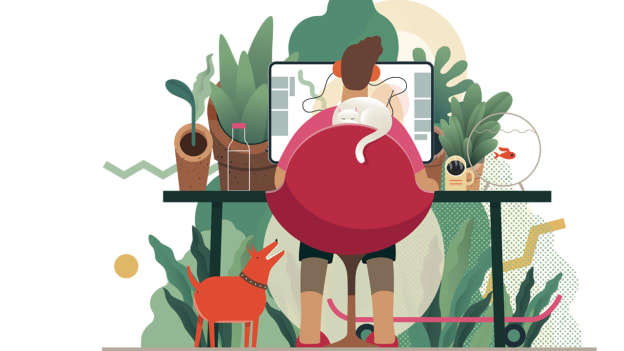From homework in childhood to work from home in adulthood

The next months will be a very strange test of our white-collar future. After the invention of the personal computer, people predicted that our jobs would eventually be emancipated from the office, and home would be the thrilling future of work. And yet, engrained work mindsets, bureaucracy, and wavering internet connections have prevented this from becoming a sweeping reality.
However, with COVID-19, all we could schedule was a screeching halt. We have rather been arm-twisted into catalyzing an anxious trial run for remote working at a grand scale— which might not be such a terrible idea for a few of us.
Nonetheless, this has taken a toll on many since change is hardly something mankind has an affinity for People are itching to get back to work; reveling in sharing their coronavirus stories over water cooler and cappuccino conversations.
Which brings us to another adage, “never let a good crisis go to waste.” This Corona wave has brought forward a much-awaited opportunity called work from home. While most of us have greeted this with a gentle smile when urgent domestic matters or work-life balance summoned it, the challenge is to turn it into the new norm—with or without a once-in-a-century public-health crisis.
So, how do we do this without losing our sanity? While in office a span of 9-10 hours made sure we took care of everything from meetings, con-calls, lunch, coffee breaks, water cooler gossips to bio-breaks, and so forth. But, in the current scenario work seems to have expanded over the time available.
Some suggestions have been echoed by all quarters:
- Create dedicated workspace
- Get dressed
- Stick to office timing
- Follow a schedule
While all these are good suggestions, and I would happily endorse them to aim at productivity levels seen during the office days. But, what about studies claiming higher productivity if we subscribed to work from home?
One of the leading reasons was employees won’t just work from 9 am to 5 pm—instead, they will cherry-pick their most-productive hours. Be it working in front of a television set, or while sipping a cup of coffee. Each one of us will discover our sweet spots when it comes to productivity. And make no mistake, they will tend to fluctuate with time, but higher productivity was promised all the way.
To delve a little further, it seems like a mix of flexibility alongside trust are the key ingredients for higher productivity. Most of us don’t indulge in an extended lunch because we are mindful of our deliverables which keeps productivity intact. Our mind is like a parachute; it works when it’s open. Hence, an open ticket to perform brings out a higher level of performance. Responsible behavior drives this performance once KPIs and performance expectations are clearly articulated and communicated. While we should not rule out governance calls completely, but at the same time, we should be wary of being overbearing. Over-governance is often interpreted as a lack of trust which drives lower productivity amongst teams. Hence, I shall make a case for letting people work at peace and to simply monitor their deliverables.
In the US, where 30% of the working population are gig workers haven’t seen any loss of productivity. In fact, they bear the same level of commitment to deliverables as full-time employees. Hence, it’s a fallacy that efficiency demands office presence. With affordable high-speed internet and video conferencing at our disposable work from home doesn’t seem far-fetched anymore. In fact, it seems to be loaded with benefits for both employers and employees. And, it's not limited to the service sector alone, even manufacturing set-ups where certain roles are well-suited for work from home do not merit physical presence on the shop floor.
But, at the same time, we can’t turn a blind eye towards a certain set of challenges. The ones like inter-departmental work, how does one collaborate on cross-functional projects? How will the very important grapevine be kept alive? How will the instant recognition work? And, various elements of group dynamics will simply seize to exist.
And it’s for reasons like these that a complete work from home is not desirable. Instead, a rhythmic pattern of work from home will be the building blocks to mature and resilient organizations.
On the brighter side, power centres and politics will have to take a back seat. People would be more concerned with maintaining work-life balance as opposed to perceptions, and as a result, focus on performance. And the so-called bell curve will solely apply to performance outcomes as opposed to perceptions. Thereby providing a more balanced and fair assessment which will lead to better acceptance of performance ratings. Not to conclude that perception will be irrelevant, but it will certainly be far less popular.
To sum it all up, I would like to pose a few questions. Is there a silver lining to the COVID-19 crisis? Will it provide opportunities for companies to save on infrastructure costs? Can organizations work with frugal workspaces, reduced electricity bills, lower conveyance claims, and so forth? How would employees react to this new working arrangement where they must commute only for important client meetings, board meetings, review meetings? Can companies compensate for personal infrastructure built by employees for office use in the form of bonuses and increments?
Now that we have some time on us, these are a few pertinent questions worth pondering over. And if you are one of those who still don’t seem to have the time, well, these are definitely a few questions worth pondering over.
















